
The British RailClass 411 (4CEP) electric multiple units were built at Eastleigh works from 1956–63 for the newly electrified main lines in Kent. These units, which used a British Railways Mark 1 bodyshell, were based on the earlier Southern Railway 4 COR design, built in 1937. Variants of the class 411 design included the class 410 and class 412 4 BEP units, which contained a buffet car in place of a standard trailer. They were later used on services in Sussex and Hampshire; following the privatisation of British Rail in 1995, the units were used by the Connex South Central, Connex South Eastern and South West Trains franchises. They were replaced by Juniper, Desiro, and Electrostar units. The fleet's lifespan was 49 years. These units are the longest-lived BR Mark 1 EMUs.

The British Rail Class 423, electric multiple unit passenger trains were mostly built by British Rail (BR) at York Works from 1967 to 1974, although the MBSOs and TSOs of the first 20, 7701-7720, were built at Derby Works. They have manually opening doors next to every seating row and were the last coaching stock built in this pattern for BR. They were mostly found working outer-suburban services in South London and rural services in Kent, Sussex and Hampshire, up to 2005 when they were finally replaced by Electrostar and Desiro units. The fleet had a working life of 38 years.
British Railways coach designations were a series of letter-codes used to identify different types of coaches, both passenger carrying and non-passenger carrying stock (NPCS). The code was generally painted on the end of the coach but non-gangwayed stock had the code painted on the side. They have been superseded by TOPS design codes.

The British Rail Class 487 electric multiple units were built by English Electric in 1940, for use on the Waterloo & City line.
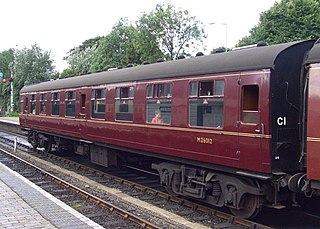
The Second Corridor type of railway carriage was one of the standard mid-20th century designs, and was coded SK by the LNER and BR, and CF by the LMS. The layout of the coach was a number of compartments, all of which were second class, linked by a side corridor.

The InterCity 225 is an electric high speed train in the United Kingdom, comprising a Class 91 electric locomotive, nine Mark 4 coaches and a Driving Van Trailer (DVT). The Class 91 locomotives were built by British Rail Engineering Limited's Crewe Works as a spin-off from the Advanced Passenger Train project, which was abandoned during the 1980s, whilst the coaches and DVT were constructed by Metro-Cammell in Birmingham and Breda in Italy, again borrowing heavily from the Advanced Passenger Train. The trains were designed to operate at up to 140 mph (225 km/h) in regular service, but are limited to 125 mph (200 km/h) principally due to a lack of cab signalling and the limitations of the current overhead line equipment. They were introduced into service between 1989 and 1991 for intercity services on the East Coast Main Line (ECML) from London King's Cross to Leeds, York and Edinburgh.

The British Rail Class 309 "Clacton Express" electric multiple units (EMUs) were built by British Rail (BR) York Carriage Works from 1962–1963. They were initially classified as Class AM9 before the introduction of TOPS. These units were the first express 25 kV alternating current (AC) units to be built by British Rail and were their first EMUs capable of 100 mph.

The British Rail TC multiple units were unpowered fixed formations of 3 or 4 carriages with a driving position at each end of the set, converted by BR's Holgate Road carriage works from locomotive-hauled Mark 1 carriages in 1966-1967 and 1974. The units built on experience gained from the prototype 6TC unit. In time the 3 car units were reformed into four car units to match the rest of the fleet and later classified as Class 442. This was later changed to Class 491, under which they spent the majority of their working lives. Shortly before withdrawal they were reclassified Class 438 and the units were renumbered to 8001-8034.
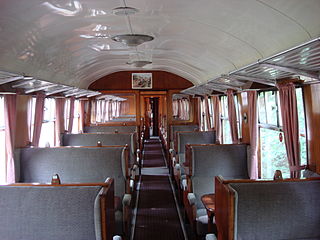
British Railways Mark 1 is the family designation for the first standardised designs of railway carriages built by British Railways (BR) from 1951 until 1974, now used only for charter services on the main lines or on preserved railways.

The Mark 2 family of railway carriages are British Rail's second design of carriages. They were built by British Rail workshops between 1964 and 1975. They were of steel construction.

The British Rail Mark 3 is a type of passenger carriage developed in response to growing competition from airlines and the car in the 1970s. A variant of the Mark 3 became the rolling stock for the High Speed Train (HST).
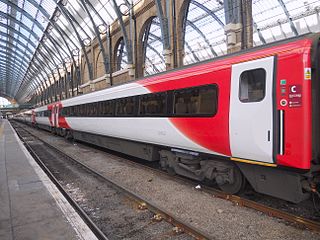
The British Rail Mark 4 is a class of passenger carriages built for use in InterCity 225 sets on the East Coast Main Line between King's Cross, Leeds and Edinburgh. Withdrawals began in 2019, with some being sold for further use with Transport for Wales between Cardiff and Holyhead.
A wide variety of hauled coaches have been used on the railways of Ireland. This page lists all those since 1945.
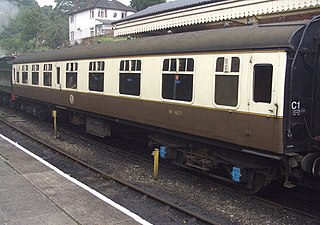
The Composite Corridor is a railway coach with a number of compartments, some of which are standard class and some first class, linked by a side corridor.

Tourist Second Open or Tourist Standard Open, abbreviated to TSO, is a type of British Railways coach. The designation "Tourist" was originally as opposed to a normal SO coach. Both types have the same number of seating bays per coach, but the TSO has four seats across, arranged 2+2 either side of a central aisle, while an SO has 3 seats across, arranged 2+1 with an offset aisle. Both offer the same legroom, but there is slightly less width per passenger in a TSO.

The British Rail Class 319 is an electric multiple unit passenger train built by British Rail Engineering Limited's Holgate Road carriage works for use on north–south cross-London services. These dual-voltage trains are capable of operating on 25 kV 50 Hz from AC overhead wires or 750 V DC from a third rail.
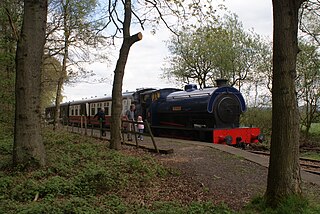
The Foxfield Railway is a preserved standard gauge line located south east of Stoke-on-Trent. The line was built in 1893 to serve the colliery at Dilhorne on the Cheadle Coalfield. It joined the North Staffordshire Railway line near Blythe Bridge. It is open at weekends and operates trains on Sundays, Bank Holidays and some Saturdays from April to October and Santa Special trains in December. It is home to the Knotty Coach Trust, The Foxfield Miniature Railway, a museum, café, bar, shop and hosts visits from the adjacent Olcote Animal Sanctuary the first three Sundays in a month.
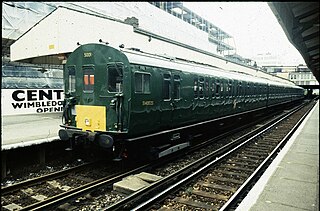
The British Rail Class 415 was a suburban 750 V DC third rail electric multiple unit commissioned by the Southern Region of British Railways. Built between 1951 and 1957, it became the most numerous class on the region after the withdrawal of the 4SUBs. The final trains were withdrawn in the 1990s, replaced by Class 455, 456, 465 and 466.

A First Open or FO, is a type of railway carriage used by British Rail and subsequent operators since privatisation. They were first produced as British Railways Mark 1, and subsequently Mark 2, Mark 3, and Mark 4 variants were produced. This type of carriage is an "open coach" because of the arrangement of the seats inside – other types of carriage may be corridor based variants (FK) or have a brake compartment.

The Mid-Norfolk Railway has a large collection of heritage rolling stock, mostly relating to the post-war British Railways-era, from the 1950s to 1990s. The line holds several rolling-stock accomplishments:



















